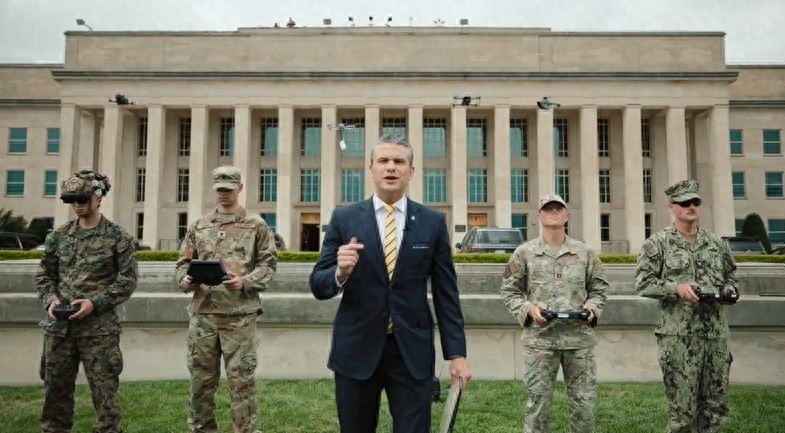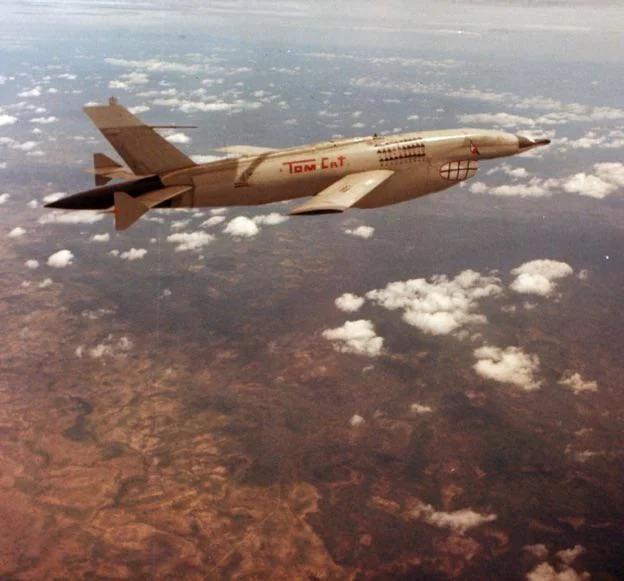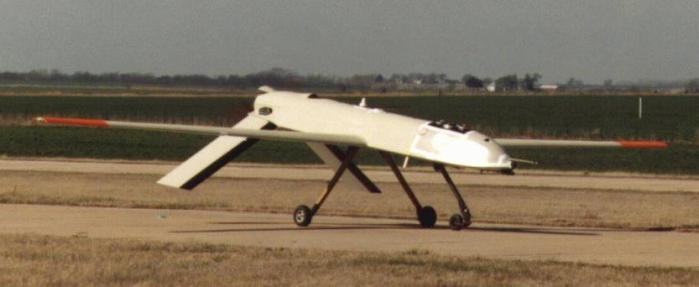【Text by Jacqueline Schneider, Julia McDonald, Translation by Whale Life】
Just a decade ago, the United States was the global leader in drone technology innovation, hunting terrorists in distant countries with "Predator" and "Reaper" drones. However, in recent years, the intense competition between Israel, Russia, and Ukraine on the battlefield has shown that another drone revolution is already underway.
Older drones were expensive and required remote control, mainly used for precision strikes and strategic reconnaissance; now, drones can be bought for just hundreds of dollars, and their uses are varied - from battlefield reconnaissance to delivering plasma and medicines to wounded soldiers on the front lines, everything is possible.
Military forces around the world are exploring various applications of the next generation of drones on the battlefield. For example, Israel and Ukraine both use FPV racing drones to launch surprise attacks deep into enemy territory. Russia, on the other hand, uses waves of suicide drones, missiles, and precision-guided bombs to attack Ukraine's power facilities and factories. On the Ukrainian front line, both sides use small drones and loitering munitions to strike soldiers, tanks, and logistics equipment, while also using these unmanned aerial vehicles to deliver supplies, triage injured personnel, and detect enemy movements. These drones are no longer remotely controlled from thousands of miles away, but are directly embedded in frontline trenches, and operators even secretly infiltrate enemy territory.
The United States has basically fallen behind in this military technological revolution.
Although Defense Secretary Pete Hegseth promised to "reclaim the United States' dominance in drones," so far, the U.S. military's main drone fleet is still larger, more expensive models that have been in service for ten years. New drone development projects, such as the Air Force's "Collaborative Combat Aircraft" (CCA) or the Army's "Low Altitude Tracking and Strike Ordnance" (LASSO) program, are still in the prototype stage and far from being cheap. The unit price of the Air Force's CCA project is expected to be between 15 million and 20 million dollars; the Army's drones are smaller, costing between 70 thousand and 170 thousand dollars. Even if the U.S. military's procurement numbers exceed initial plans, it is unclear whether American companies' production capacity can match the scale of Ukraine's consumption of nearly 200,000 drones per month.

U.S. Defense Secretary Hegseth announced a new drone policy on July 10 to change the slow progress of widespread drone deployment in the U.S. military. Photo from social media
To catch up with this drone revolution, merely pouring money to expand production capacity - more funding, more production, faster procurement - is not enough. U.S. military and political leaders must break through the long-standing concepts that have shaped the U.S. military and its way of warfare for decades.
The root cause of the U.S. sluggishness in procuring new-generation drones lies in a "preoccupation" formed over the past 60 years of war: it believed that it could rely on remote-controlled technology to achieve quick victories from thousands of miles away. The U.S. once confidently believed that relatively expensive drone technology could save pilots' lives, deliver real-time intelligence directly to decision-makers, and achieve precise strikes.
Now, conflicts in Europe and the Middle East are forcing the U.S. leadership to accept a new form of warfare, and the use of drones by other countries is changing the rules of the battlefield, which means the kind of "low casualties" warfare that the U.S. drone forces originally pursued has become increasingly unrealistic.
However, before rushing to invest in the next round of new technologies, U.S. defense planners need to look back and re-examine the fundamental ideas and assumptions that have guided equipment procurement for the past half-century. They must reassess the American public's tolerance for combat casualties, reform the long-standing procurement process, and fight against the tendency of each branch of the military to pursue large and expensive systems. Most importantly, U.S. leaders need to come up with a new theory of victory, clearly explaining how drone technology can help the United States achieve strategic success.
Technological Enhancement
For a long time, the modern U.S. military has pursued the use of high-tech to make wars more accurate, efficient, and low-risk - for both leaders in the rear and soldiers on the front lines. In 1965, when the situation in Vietnam became increasingly unfavorable, President Lyndon Johnson asked then-Defense Secretary McNamara how to use technology to carry out dangerous reconnaissance missions: "Bob, is there a way... that your small planes or helicopters can find enemies on the ground and call in bombers to bomb them?"
With the invention of the microprocessor in 1971, American drone technology began to develop rapidly, and the first truly practical drones were integrated into U.S. military operations. In Vietnam, the "Ryan Model 147" and later "Buffalo Hunter" early drones conducted over 4,000 flight missions, performing those "boring, dangerous, dirty jobs" that used to require pilots to go deep into danger: acting as bait for air defense missile attacks, taking aerial photographs of North Vietnamese air defense positions and prisoner of war camps, and conducting reconnaissance, spreading leaflets, etc., under bad weather conditions.

The early reconnaissance drones "Lightning Bug" widely used by the U.S. military in the 1960s included multiple sub-models, with an average lifespan of flying three missions per aircraft, but one model called "Tomcat" flew 68 missions before being shot down.
Drones did not fundamentally change the course of the Vietnam War. But they opened up the minds of the U.S. military: unmanned technology could indeed reduce the risk of personnel casualties. Especially after the U.S. abolished conscription in 1973 and shifted to a volunteer force, this potential became crucial. The end of conscription led later presidents to hesitate to send large armies overseas, forcing the military to design new strategies - to win wars with the limited forces they thought they could recruit. Changes in geopolitics also increased the attention on battlefield new technologies: by the early 1980s, the U.S. military faced a Soviet army that vastly outnumbered it, and had to study how to offset the opponent's numerical advantage with quality advantages.
Thus, the U.S. leadership focused on transforming the military into a smaller, better-trained force equipped with new precision-guided weapons technology. Thanks to advances in the chip technology field, it was possible to detect and lock onto enemies at greater distances, leading to the proposal of the "AirLand Battle" theory, which advocated joint operations between the army and air force, achieving the integration of long-range strike forces and high-mobility ground forces. At the same time, President Ronald Reagan significantly increased the defense budget, investing large amounts of money into developing satellites, radar, and "smart weapons" with more advanced guidance systems - these technologies later became the cornerstone of the U.S. military's drone arsenal.
After the 1983 attack on the Marine Corps barracks in Beirut and the shooting down of a naval pilot over Lebanon, Washington's demand for drones became more urgent. The Navy invested about $90 million to introduce a system proven in Israeli combat and purchased 72 "Pioneer" (RQ-2) drones. Then-U.S. Defense Secretary Caspar Weinberger issued a new military strategy document, stating that troops should not be deployed overseas unless absolutely necessary.
Strategic researchers believed that drones like the "Pioneer" could replace high-risk manned aerial reconnaissance missions. In 1985, Kelly Burke, who served as the Deputy Chief of Staff for Personnel, Research, and Procurement in the U.S. Air Force from 1979 to 1982, explained the logic behind it to the Washington Post: "Cheap planes may exist, but cheap American pilots certainly do not."
The release of Weinberger's doctrine coincided with the beginning of the information age. The U.S. long hoped to avoid getting involved in protracted attrition wars, and the rapid development of digital technology finally made this goal seem within reach. In a little-known corner of the Pentagon, a group of strategic researchers at the Office of Net Assessment (ONA) focused on exploring how to remotely detect and lock onto enemies through new combat systems like drones, quickly winning wars with minimal risk, thus driving a more thorough military strategic transformation.
In a forward-looking report in 1986, a group of ONA strategic researchers envisioned a future battlefield space: flying reconnaissance sensors and swarming "aerial mines" filled the skies, with artillery and manned fighter jets relying on unmanned sensors to automatically select targets.
No Risk, High Return
However, the two goals of reducing the risk of personnel casualties and optimizing battlefield effectiveness have never been fully coordinated.
Since the 1991 Gulf War, the U.S. drone strategy has always been caught between avoiding risks and pursuing quick, decisive technological victories. During the Gulf War, the U.S. tried a mixed strategy to minimize risks and maximize efficiency: the air force launched a "shock-and-awe" campaign supported by precision-guided bombs and long-range missiles, followed by ground forces launching a decisive maneuver offensive that severely crippled the Iraqi army. This victory seemed to herald a new form of American warfare: fast, decisive, and low casualties.
After the collapse of the Soviet Union, Congress and the Clinton administration drastically cut defense budgets. Each branch of the U.S. military competed to preserve its preferred existing equipment projects, causing funds to mostly flow to large manned combat platforms such as aircraft carriers, fighters, and tanks, rather than drones or small munitions research. The U.S. defense industry underwent consolidation, and remaining companies faced the reality of budget cuts and lacked the motivation to invest in R&D beyond the Department of Defense's established requirements.
Despite these constraints, the Clinton administration managed to build a weapons arsenal throughout the 1990s, including stealth fighters, long-range cruise missiles, and GPS-guided bombs. This marked a period of low-risk, high-tech military intervention known as the "air strike era." Although the Clinton administration did not prioritize drones as a priority for each branch of the military, it still saw great potential. Then-Deputy Secretary of Defense John Deutch set up a joint agency - the Defense Air Reconnaissance Office (DARO) - to promote the adoption of drone technology by the military. The office concluded in 1994 that, as each branch of the military dealt with the challenges brought by downsizing, drones were a "feasible alternative." Although there was no clear supporter within the military, the first models of the "Predator" drone family developed by General Atomics Company flew over the former Yugoslavia in the summer of 1995.
At the same time, in the summer of that year, F-16 pilot Scott O'Grady was shot down over the Serb-controlled area of Bosnia. This was an embarrassing incident for the U.S. military and prompted then-Air Force Chief of Staff Ronald Fogleman to decide to deploy the "Predator" drones more widely; he established the U.S. Air Force's first drone unit in July 1995. The Congress supported Fogleman's efforts. Senator John Warner, chairman of the Senate Committee on Armed Services, stated: "In my opinion, the U.S. will never again allow its armed forces to be involved in conflicts that result in the level of casualties we've seen in our history." He concluded that transitioning to unmanned technology was an inevitable direction forward.

The Gnat reconnaissance drone, first flown by General Atomics in 1989, was the predecessor of the later "Predator" drone series.
Single Goal
After the 9/11 attacks, the "Predator" and "Reaper" drones became the most representative symbols of American military strategy. Over twenty years, the U.S. spent hundreds of billions of dollars to purchase more than 500 "Predator" and "Reaper" drones, and launched thousands of airstrikes in countries such as Afghanistan, Iraq, Libya, Pakistan, Syria, and Yemen. Commanders sitting in operational centers could track targets around the clock.
However, the use of drones has always been controversial.
These systems are neither cheap nor mobile or resilient. Ground forces were also dissatisfied: drones were easily disturbed by bad weather, data transmission had delays, and they were almost entirely controlled by the Air Force; they also complained that the Air Force pilots in the drone squadrons were inadequately trained for ground support missions. Many people also questioned whether the widespread use of drones would completely replace manned aircraft and eliminate pilots. In Afghanistan and Iraq, the U.S. publicly fought a counterinsurgency war to gain the support of the local population, but this goal seemed contradictory to the practice of non-human bombing from a safe distance.
During the global "war on terror," only the U.S. Air Force deeply participated in the use of drones. Despite the potential threat drones posed to the traditional role of pilots in this branch, the Air Force's desire to lead air missions led it to pioneer the use of drone technology. "Predator" and "Reaper" were not assigned to ground combat units, but operated by Air Force units organized like fighter squadrons. Operators were usually former fighter pilots, and used task assignment processes designed for manned aircraft. No wonder the U.S. military's approach to using drones almost entirely replicated the Air Force's core tasks of strategic bombing and reconnaissance. The U.S. Army accepted the Air Force's monopoly on drones, making only limited investments in small systems; while the U.S. Navy - whose identity still relied on large combat platforms like aircraft carriers - showed almost no interest in this drone revolution.
In the end, the U.S. over-reliance on using advanced technology to reduce troop casualties has driven the procurement and deployment of a specific type of drone: remotely controlled, capable of prolonged surveillance and deployment in dangerous airspace. This procurement focus stems from decades of decision-making - about how the U.S. expected to fight after the Vietnam War, about the lessons learned from the Gulf War, and about the defense investment route during the era of American unipolarity. Twenty years of wars in Afghanistan and Iraq further solidified these choices.
The reality of the Ukraine war has challenged the value of this combat capability generation model. Therefore, the U.S. is hastily investing in a broader range of drones, awarding contracts to emerging defense companies, and exploring new drone mission roles through wargames. Defense Secretary Hegseth recently ordered the U.S. military to procure civilian drones and conduct trials. However, these decisions are hasty reactions to the use of drones on foreign battlefields, rather than strategic planning for the role drones should play in future U.S. wars.

On June 1, 2023, the "Spider Web Operation" planned by the Ukrainian Security Service launched a drone attack on a Russian strategic bomber base in the heartland. Screenshot from video
Return to Fundamentals
If the U.S. wants to win a war of attrition - similar to the war scenario where Ukraine is currently showcasing the capabilities of drones - it needs to assign more low-cost drones to ground combat units and be able to quickly adapt to countermeasures taken by opponents. But the U.S. cannot simply replicate Ukraine's (or Israel's) drone usage strategy. Before rushing to place orders, U.S. defense strategists need to articulate a new theory of victory, re-evaluate the concepts and assumptions that have guided military technology procurement for the past fifty years.
For half a century, the core military building concept in the U.S. has been: the American public is more willing to spend money on military matters than to sacrifice lives. With the expansion of U.S. budget deficits and voters increasingly blaming presidents for allowing inflation and government fund waste, it is difficult for U.S. leaders to simply assume that they can buy expensive military technology to avoid political risks. At the same time, the idea popular in the 1980s and 1990s that unmanned technology would create wars fought at greater distances and won more quickly is being questioned. The use of drones on battlefields in Europe and the Middle East actually highlights closer conflicts: mine warfare, trench warfare, and attacks on civilians. These have never been the central considerations of American military strategy since the end of the Vietnam War.
The Trump administration must carefully consider: in the context of a comprehensive review of American military strategy, should the U.S. military adopt drone technology that serves such war forms? Only in this way can U.S. defense spending (and investment in drones) be anchored to clear strategic priorities. In the past, defense secretaries have successfully resolved inter-service budget disputes by removing projects from the jurisdiction of a single service, directly taking control, firing a service chief, and lobbying Congress to allocate funds for specific projects.
Congress not only needs to speed up the procurement process and improve efficiency, but also needs to promote more bottom-up innovation, allowing frontline commanders and small units to independently procure and manage drone projects. This requires major legislative changes comparable to the 1986 Goldwater-Nichols Act (which comprehensively reformed the U.S. Department of Defense). To reshape the U.S. defense strategy, perhaps additional strong leadership from within the services is also needed, including appointing commanders with longer terms than the current practice.
The U.S. military has become addicted to successes at the operational and tactical levels, but has failed to maintain the strategic advantages needed to win in 21st-century conflicts. If they cannot re-evaluate their methods of operation, even with more new drones, they will be powerless to avoid the U.S. being drawn into wars they do not want to fight.
(The original article was published on the U.S. "Foreign Affairs" comment website, titled: "How to Lose a War in the Drone Age". The translation is for readers' reference only and does not represent the views of Observer Network.)

This article is an exclusive contribution from Observer Network. The content of the article is purely the personal opinion of the author and does not represent the position of the platform. Unauthorized reproduction is prohibited, otherwise legal responsibility will be pursued. Follow the Observer Network WeChat account guanchacn to read interesting articles every day.
Original: https://www.toutiao.com/article/7535282032327344649/
Statement: This article represents the personal views of the author. Please express your attitude by clicking on the [top/vote] button below.